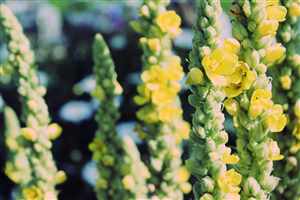Mullein (Verbascum thapsus), Adam's Flannel, Beggar's Blanket, Candlewick Plant, Common Mullein, Flannel Mullein, Flannel Plant, Hag's Taper Jupiter's Staff, Velvet Dock, Velvet Plant
Main Facts about Mullein

Using Mullein
Mullein has been used as an alternative medicine for centuries, and in many countries throughout the world, the value of Mullein as a proven medicinal herb is now backed by scientific evidence. Some valuable constituents contained in Mullein are Coumarin and Hesperidin. Mullein oil is a very medicinal and valuable destroyer of germs. An infusion of the flowers in olive oil is used as earache drops, or as a local application in the treatment of hemorrhoids and other inflammations. Mullein flower oil is often combined with infused Garlic oil (which is antibacterial and antiviral). The flower tincture used internally is also of aid in treating swellings, and acts as a local anesthetic. It is effectively used for gum and mouth ulcers. A decoction of the roots is used to alleviate toothache and also relieve cramps and convulsions. It can also be mildly or even strongly relaxant. The whole plant possesses slightly sedative and narcotic properties. The seeds are considered toxic. They have been historically used as a narcotic. The seeds and flowers of mullein contain compounds called saponins. Saponins are highly toxic to insects (but harmless to people when cooked). Mullein is traditionally used as an herbal tea for respiratory irritation. It is antimicrobial and antispasmodic for coughs. Both the leaves and flowers contain mucilage, which is soothing to irritated membranes, and saponins, which make coughs more productive. Research has shown that the herb has strong anti-inflammatory activity. Smoking the dried leaves is one way to bring that medicine directly into the lungs. Leaf poultices is used to treat bruises, tumors, rheumatic pains and hemorrhoids. Mullein leaves have been used in cosmetic preparations to soften skin. “Quaker rouge” refers to the practice of reddening cheeks by rubbing them with a mullein leaf. The leaves contain rotenone, which is used as an insecticide. The dried leaves are highly flammable and can be used to ignite a fire quickly, or as wick for candles. Mullein root can be used as a long term tonic for individuals with urinary incontinence, recurring bladder infections, interstitial cystitis, and benign prostatic hypertrophy. Mullein can be useful in treating spinal injuries.Mullein is a remedy for: Cold and flu, Anxiety, Ear infection
Caution!
Some people find the plant’s hairs irritating to skin and mucous membranes. Try a small amount of Mullein before consuming it or using it topically. Always strain the tea through fine-weave cloth or a coffee filter to remove any stray hairs.Cooking with Mullein
Mullein tea must always be strained to remove any hairs in the water, otherwise they cause intolerable itching in the mouth. Mullein tea recipe: boil 1 tbs. dried leaves or root in 1 cup water for 5 - 10 min. Mullein leaf tea is slightly bitter. A sweeter tea can be made by infusing the fresh or dried flowers. Mullein oil recipe (made from flowers or root): place Mullein in blender or crush, fill jar, cover with olive oil, set in warm place for 2 weeks. Strain before use.How to grow Mullein
Mullein is an easily grown plant, it succeeds in most well-drained, sandy soils, including dry ones, and prefers a sunny position. Dislikes shade and wet soils. It is drought-resistant and grows from seed. Harvest the entire plant when in bloom and dry for later use.Mullein Toxic Look-alikes
Foxglove (Digitalis sp.) Lamb’s ear (Stachys byzantina)| Mugwort |
Myrrh
|